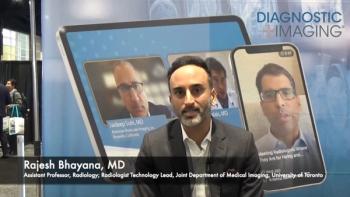
COVID-19 Imminent in the U.S.: How Radiologists Can Reduce the Spread
Superior diagnosis with CT requires safety planning.
The arrival and spread of novel coronavirus (COVID-19) in the United States is now considered, by the Centers for Disease Control and Prevention (CDC), to be nearly inevitable. As the medical providers at the front line of diagnosis, radiologists must be prepared to handle the looming influx of patients.
As of Feb. 26, COVID-19 has infected 81,386 individuals worldwide and has caused 2,771 deaths. Health officials anticipate that number will continue to rise, and part of combatting a wider spread is preparing for the amount of CT scans that will be ordered.
Because most patients present with respiratory distress, CT scans are recommended as the primary screening tool as it identifies potential virus cases faster than any other method. Recent data published in
Consequently, it’s imperative for radiologists to be familiar with the possible symptoms associated with COVID-19 before the virus shows up on the nation’s doorstep. Pneumonia is the initial diagnosis, and imaging findings are largely bilateral with subpleural and peripheral distribution, ranging from ground-glass opacities in milder forms to consolidation in severe cases.
Preparing Your Practice to Limit Virus Transmission
It's also vital for radiologists to take protective steps. As COVID-19 has not yet made any significant appearance state-side, practices and hospitals have time to prepare. Guidance, recently published in the
The first step, according to a team led by the University of Southern California Keck School of Medicine, is to establish a protection protocol.
“A multi-disciplinary committee should convene to outline guidelines for imaging facility personnel to prevent virus spread through human-to-human contact and the department equipment,” they wrote. “Implementation of a robust plan can provide protection against further transmission of the virus to patients and staff members.”
COVID-19 is believed to transmit via respiratory droplets, but it’s currently unknown whether it can also be transmitted by touching a contaminated surface. Consequently, the team recommends facilities follow these protective measures:
- Use portable radiographic equipment to limit the transportation of patients whenever possible. Previous experience with the SARS virus shows dedicating equipment for use on infected patients can limit the risk of virus transmission.
- Patients who must be transported to the radiology department must wear a surgical mask. The CDC recommends a fit-tested N95 mask or higher, and a surgical mask can be used if an N95 mask isn’t available.
- Disinfect each CT and MR gantry, as well as noninvasive ultrasound probes, blood pressure cuffs, and image viewing station mice and keyboards after every contact with a patient suspected of COVID-19 infection. Wash them with warm water and soap or decontaminate them with a low-level or intermediate-level disinfectant, such as iodophor germicidal detergent solution, ethyl alcohol, or isopropyl alcohol. To ensure you’re using the safest disinfectant for each piece of equipment, contact the product manufacturer.
Practices who take the time, particularly before COVID-19 infections pop up in the United States, to implement these safety procedures, the team advised, will have a much better chance of limiting virus transmission and keeping employees safe.
Newsletter
Stay at the forefront of radiology with the Diagnostic Imaging newsletter, delivering the latest news, clinical insights, and imaging advancements for today’s radiologists.




























